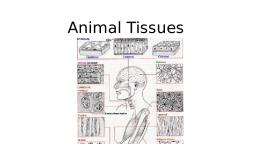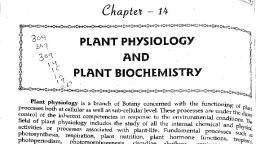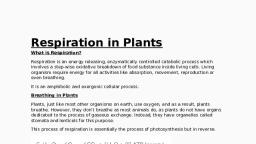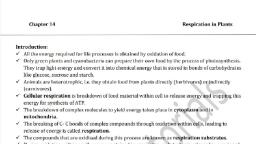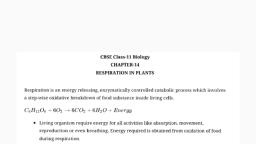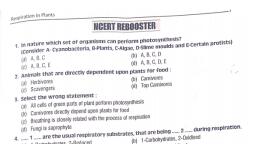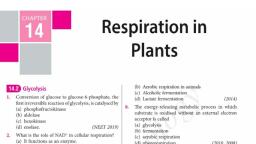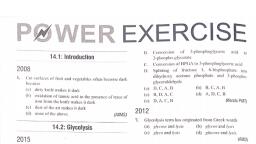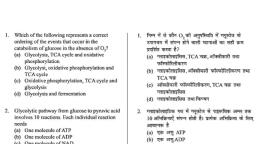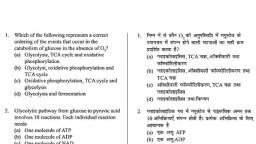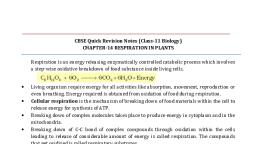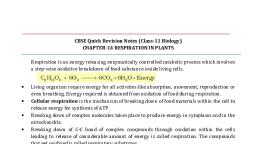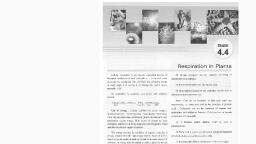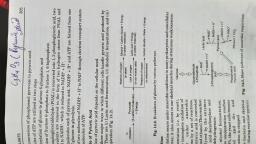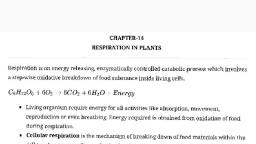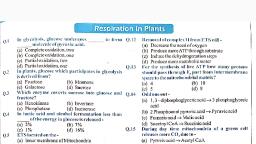Page 1 :
Chapter 14‐ RESPIRATION IN PLANTS, Living cells require a continuous supply, of energy for maintaining various life, activities. This energy is obtained by, oxidizing the organic food substances, present in the cells. The food, substances, like, Carbohydrates,, proteins, fats which, are used for, oxidation during respiration are called, ‘respiratory, substrates’., Vikasana, – Bridge Course 2012
Page 2 :
What is respiration?, It is a cellular catabolic process, in which, the organic food substances (Glucose﴿, are oxidized completely or partially with, or without using oxygen, resulting in the, formation of ATP molecules. The energy, present in the chemical bonds of, glucose molecule will be transferred to, the phosphate bonds of ATP during, respiration., Vikasana – Bridge Course 2012
Page 3 :
Adenosine Tri phosphate (ATP), ATP is, currency’., i also, l called, ll d ‘energy, ‘, ’ Cells, C ll, depend upon the energy stored in the, phosphate, h, h t bonds, b d off ATP molecule, l, l for, f all, ll, their energy needs. ATP has usable form, off energy. The, Th normall bonds, b d C-C, C C and, d CC, H bonds present in the food substances, yield, i ld less, l, energy while, hil the, th phosphate, h, h t, bond of ATP yield 7.3 k cals ., ADP + Pi →ATP, ATP, (Ph, (Phosphorylation﴿, h, l, ti, ﴿, Vikasana – Bridge Course 2012
Page 4 :
Structure of ATP, , Vikasana – Bridge Course 2012
Page 5 :
Types of respiration, There are two types of respiration., 1. Aerobic respiration, respiration- takes place in the, cells of higher plants and animals,, using oxygen for the oxidation of, glucose., 2. Anaerobic respiration, respiration- takes place, in, microorganisms without using oxygen for, the oxidation of glucose., Vikasana – Bridge Course 2012
Page 7 :
Glycolysis (Glyco= sugar, Lysis=breaking), It is the first step of respiration and is, common to both aerobic and, anaerobic respirations. It takes place, in the cytoplasm of the cell., cell, In, glycolysis, 6C, Glucose, is, enzymaticaly broken down in a step, wise (10) manner into 2 molecules of, 3C pyruvic acid ., Vikasana – Bridge Course 2012
Page 9 :
Hydrogen carriers in respiration, The Hydrogen carriers in respiration are, NAD, (Nicotinamide, Adenine, Di, nucleotide) and FAD (Flavin Adenine Di, Nucleotide. They can accept free, Hydrogen atom released in the cell, during metabolic reactions. Their role is, to transport the hydrogen atoms of, glucsoe to the the ETS., Vikasana – Bridge Course 2012
Page 10 :
Hydrogen acceptors, NAD (OXI) + Hydrogen, FAD (OXI) +Hydrogen, , NADH (Red), FADH (Red), , In the ETS, the electron of hydrogen atom, pass through series of electron carriers., During this electron movement, at several, steps energy is used for the joining of Pi, to ADP to get a molecule of ATP., Vikasana – Bridge Course 2012
Page 13 :
Mitochondia- The power house of the cell, , Vikasana – Bridge Course 2012
Page 17 :
Electron transport system (ETS/ETC), It is the third step in aerobic respiration,, respiration, in which oxygen is used. It opertes on, the Racker, Racker’s, s particles present on the, cristae of Mitochondira. In this step, NADH and FADH, formed during, glycolysis and Kreb’s cycle get, oxidized The Hydrogen released by, oxidized., them dissociates into proton and, electron, electron., Vikasana – Bridge Course 2012
Page 18 :
ETS‐ oxidative phosphorylation, Then as the electrons pass through, series electron carriers of ETS, ADP is, phosphorylated to ATP., , Vikasana – Bridge Course 2012
Page 20 :
Terminal oxidation, Oxidation of one NADH yields 3ATP and, one FADH gives 2 ATP molecules. At the, end of ETS, molecular oxygen combines, with hydrogen to form water. Hence it, is called terminal oxidation. Thus the, other product of aerobic respiration, water is formed during ETS., Vikasana – Bridge Course 2012
Page 21 :
ATP account during aerobic respiration, Pathway, , Substrate-Level, Phosphorylation, , Oxidative, Phosphorylation, , Gl, Glycolysis, l i, , 2 ATP, , Preparatory step, , -, , 2 NADH = 6 ATP, , 6, , Krebs Cycle, , 2 ATP, , 6 NADH = 18 ATP, 2 FADH2 = 4 ATP, , 24, , TOTAL, , 4 ATP, , 34 ATP, , 38, , 2 NADH = 6 A T P, , Vikasana – Bridge Course 2012, , Total, ATP, , 8
Page 22 :
Summary‐ Aerobic respiration, Glucose (C6 H12 O6 ) + 6O2→6CO2 + 6H2 O +38ATP, , 1. Glucose is completely oxidized., 1, oxidized, 2. Takes place in the cells of higher plants, and animals, 3. Takes place in the cytoplasm and, mitochondria of the cell,, cell in three steps., steps, 4. Products are 6CO2 + 6H2 O +38ATP, Vikasana – Bridge Course 2012
Page 23 :
Anaerobic respiration, It is the partial oxidation of glucose, molecule without using oxygen., Anaerobic respiration which takes place, in, microorganisms, is, called, ‘fermentation’., There are two types of fermentation, depending upon the end products., 1. Ethyl alcohol fermentation, 2. Lactic acid, fermentation, Vikasana, – Bridge Course 2012
Page 25 :
Ethyl alcohol fermentation, , Vikasana – Bridge Course 2012
Page 26 :
Lactic acid fermentation, It takes, in, t k place, l, i some bacteria, b t i and, d animal, i l, tissue when oxygen is absent. The end, product, d t Is, I lactic, l ti acid., id, y, acid + NADH+H+ 2ATP, 1.Glucose →Pyruvic, 2.Pyruvic, y, acid+NADH+H→Lactic acid+NAD, Fermentation p, process has wide industrial, application. Vikasana – Bridge Course 2012
Page 27 :
Differences between aerobic and anaerobic, i ti, respiration, y Aerobic, , y Anaerobic, , y Oxygen is used for the process, , y oxygen is not utilized for the, , y Takes p, place in the cells of, , higher plants and animals, y Glucose is completely oxidized, y The end products are carbon, dioxide and water, y Complete oxidation of one, , molecule of glucose yields 38, ATP molecules, y Process takes place in both, cytoplasm and mitochondria of, the cell., , y, y, y, , y, , y, y, , process., Takes place normally in some, bacteria, and fungi ., Glucose is partially oxidized, The end p, products are carbon, dioxide and either ethyl, alcohol or lactic acid, Partial oxidation of one, molecule of glucose yields, only 2 ATP molecules., Takes p, place only, y in, cytoplasm of the cell
Page 28 :
Respiratory quotient (RQ), Respiratory quotient is the ratio of volume, of carbon dioxide released to the volume of, oxygen consumed during respiration, respiration., RQ value indicates the type of substrate, used during respiration, Volume of carbon dioxide evolved, , RQ =--------------- -----------during, d i respiration, i ti, Volume of oxygen consumed, , Vikasana – Bridge Course 2012
Page 29 :
RQ values, RQ value of carbohydrate, y, is one, RQ value of proteins and fats is <one (0.7, to 0.9)), RQ value of organic acids is > one (1.3 to, 4)), RQ value in anaerobic respiration is, infinity, y as oxygen, yg is not used., Vikasana – Bridge Course 2012
Page 30 :
Summary, p, py a p, is simply, process where in the, Respiration, unusable energy present In glucose molecule, p wise, is transferred to ATP molecule in a step, manner., p wise transfer p, prevents loss of energy, gy ., Step, Respiration makes energy available to the, cells for their vital activities., It can be of aerobic type or anaerobic type., Anaerobic respiration has wide industrial, application. Vikasana – Bridge Course 2012
Page 31 :
Thank you, , Vikasana – Bridge Course 2012
